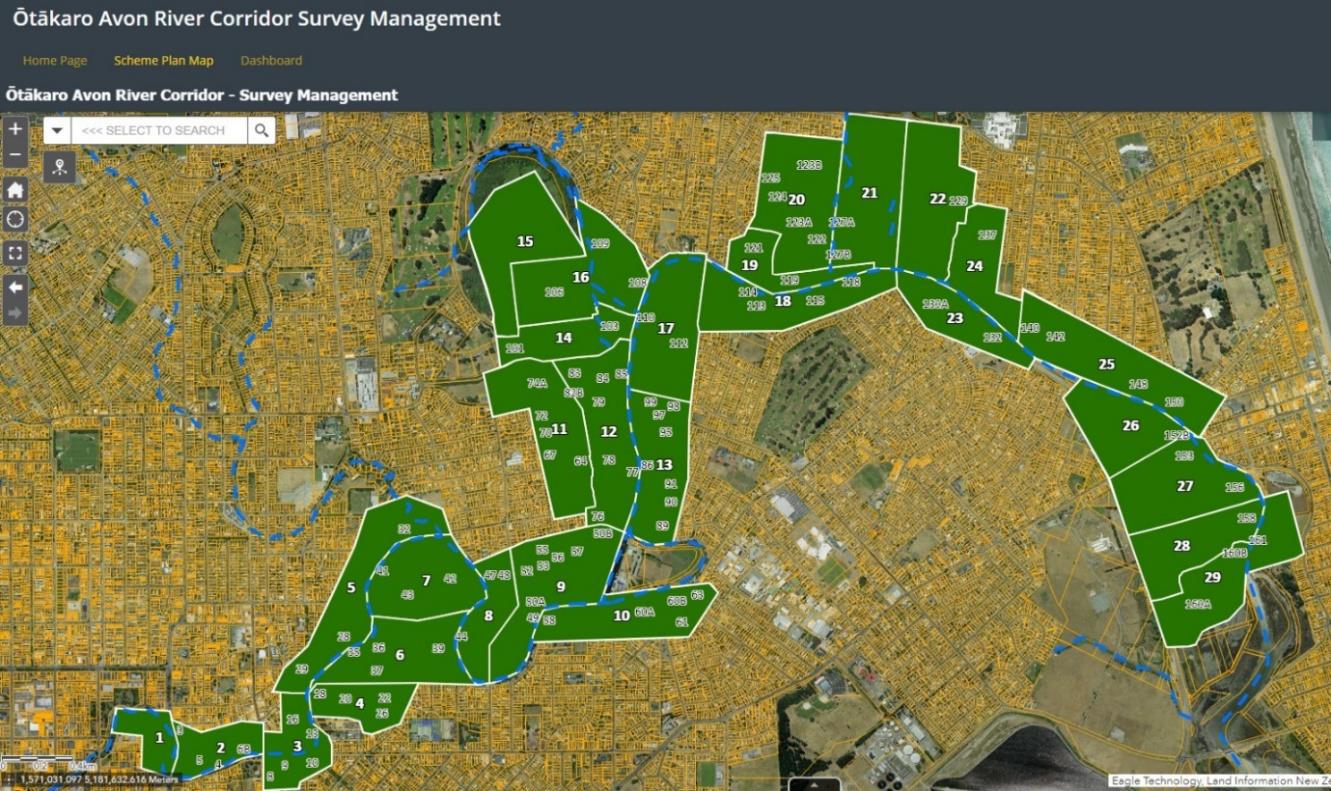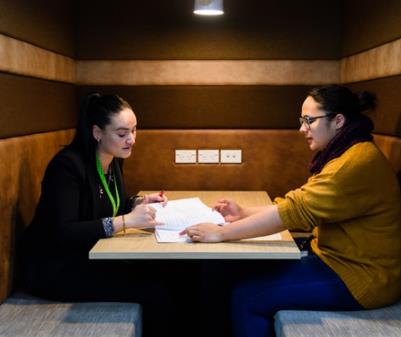

RELEASED UNDER THE
OFFICIAL
Property rights
Land Information Portfolio
INFORMATION
ACT
November 2023
link to page 3 link to page 5 link to page 5 link to page 6 link to page 7 link to page 7 link to page 8 link to page 8 link to page 11 link to page 16 link to page 16 link to page 22 link to page 23 link to page 24 link to page 25
Property rights
Contents
1
Introduction ............................................................................................................................ 3
2
Your role as Minister for Land Information ......................................................................... 5
2.1 Maintaining the legislative regime for holding and transferring property ......................................... 5
RELEASED
OFFICIAL
2.2 Overseeing completion of the Survey and Title Enhancement Programme ...................................... 6
2.3 Deciding on survey and title fees and charges .............................................................................................. 7
2.4 Directing LINZ on areas of policy development ............................................................................................ 7
3
Main areas of property rights activity .................................................................................. 8
3.1 Defining property boundaries ............................................................................................................................... 8
3.2 Administering land titles and other interests in land ............................................................................... 11
4
Upcoming opportunities ...................................................................................................... 16
4.1 Completing the Survey and Title Enhancement Programme ................................................................ 16
INFORMATION
4.2 Reviewing survey and title fees and charges ............................................................................................... 22
UNDER
5
Outlook for property rights ................................................................................................. 23
6
Next steps ............................................................................................................................. 24
Annex 1 Critical relationships ....................................................................................................... 25
THE
ACT
2
Property rights
1 Introduction
This briefing on property rights supplements your initial briefing on the Land Information
portfolio.
Property rights is one of four regimes covered in supplementary briefings.
RELEASED
OFFICIAL
Figure 1: LINZ regimes covered in supplementary briefings
Regimes
Main activities
Main legislation
Overseas
Ensure permitted investments in New
Overseas Investment Act 2005
investment
Zealand’s sensitive assets by overseas
persons provide net benefits to New
Zealand
Property rights
Administer a state-guaranteed
Cadastral Survey Act 2002, Land
regime of property rights, restrictions
Transfer Act 2017
INFORMATION
and responsibilities over land and
property in New Zealand UNDER
Geographic and
Providing information that New
Valuers Act 1948, Rating
property
Zealanders value when making land,
Valuations Act 1998, New
information
sea and property-related decisions,
Zealand Geographic Board (Ngā
as well as informing local and central
Pou Taunaha o Aotearoa) Act
government decision-making on
2008
issues like emergency response and
climate change
THE
Crown land
Administer Crown land, and the
Land Act 1948, Public Works Act
regime for acquiring and disposing
1981, Crown Pastoral Land Act
of land in a way that balances both
1998
the public interest and private
property rights
ACT
This briefing discusses:
• your role in relation to property rights
• activity in the property rights regime
• upcoming opportunities
• the outlook for property rights
• suggested next steps.
3
Property rights
Facts at a glance
15% GDP
The survey and title regime is
administered through Landonline.
In the last financial year there were:
Property services is one of New
Zealand’s largest contributing
RELEASED
OFFICIAL
3.2 million
industries to GDP.
1
logins to Landonline, the platform
In the property rights regime in the last
for New Zealand’s property regime,
year there were:
up from 3 million in the 2021/22
financial year. Landonline has
3,283,424
13,551 active users, which include
surveyors, solicitors and
property search products delivered
conveyancing professionals, banks,
(through both Landonline and
councils and real estate agents.
Land Record Search).
INFORMATION
2,697,174
67
UNDER
territorial authorities in New
parcels in the cadastre (including
Zealand have gone live with
road and water parcels such as
Notice of Change of Ownership
rivers, lakes and the seabed).
in Landonline.
2,361,206
live titles in the register.
THE
ACT
1 Source: Stats NZ 2021
. Gross domestic product (GDP) | Stats NZ Includes owner-occupied property operation, rental hiring,
and real estate services.
4
Property rights
2 Your role as Minister for Land Information
Your main roles in relation to property rights are ensuring Toitū Te Whenua Land
Information New Zealand (LINZ) maintains the legislative framework for holding
and transferring property, overseeing the modernisation of the land registry
digital platform (Landonline), deciding on survey and title fees and charges, and
RELEASED
OFFICIAL
directing LINZ on any areas of policy development.
2.1 Maintaining the legislative regime for holding
and transferring property
You are responsible for administering the Land Transfer Act 2017 and the Cadastral
Survey Act 2002. These Acts set the legislative regime for holding and transferring land
and related property in New Zealand. The property rights regime is one of the
foundations of the economy.
INFORMATION
Figure 2: Legislative regimes for holding and transferring land and related property
UNDER
Land Transfer Act 2017
Cadastral Survey Act 2002
• Maintains the Torrens system of land
• Requires the Surveyor-General to
title in New Zealand, the principles of
maintain a national geodetic regime
which are to:
and a national survey control regime
o provide security of ownership of
• Provides for the electronic lodging and
estates and interests in land
processing of cadastral surveys
o facilitate the transfer of and
• Promotes and maintains the accuracy of
dealings with estates and
the cadastre by:
interests in land
THE
o requiring cadastral surveys to be
o provide compensation for any
done by, or under the direction of,
losses arising from the operation
licensed cadastral surveyors
of the system
o requiring cadastral surveyors to
o provide a register of land that
meet standards of competence to
describes and records the
be licensed
ACT
ownership of estates and
o providing for the setting of
interests in land.
standards for cadastral surveys and
cadastral survey data.
LINZ considers that this legislative regime is performing well and is one of the reasons
New Zealand has an international reputation for a secure and efficient property rights
regime.
Your role in maintaining the property rights legislative regime is likely to focus on how
the regime connects to reform in other ministerial portfolios.
5
Property rights
Legislation for property rights is closely connected to legislation for development,
housing, the environment, Māori land, and overseas investment. Reform in any of these
areas will require your involvement to meet desired outcomes while maintaining the
integrity of the property rights regime.
A recent example is the July 2023 release of a Ministry of Business, Innovation and
Employment discussion document on anti-competitive land agreements. LINZ helped
RELEASED
OFFICIAL
prepare this discussion document given the role of the Land Information portfolio in
administering the property rights regime.
LINZ will identify property rights implications of government initiatives in its weekly
updates to you, so that you can discuss them in the following week’s officials
meeting.
2.2
Overseeing completion of the Survey and Title
Enhancement Programme
INFORMATION
LINZ administers the property rights regime using an information technology platform
called Landonline. The key users of Landonline include lawyers, conveyancers and
UNDER
surveyors, working on behalf of their clients.
LINZ is almost two-thirds of the way through the Survey and Title Enhancement
Programme (STEP), a major upgrade to Landonline. STEP is one of the government’s
larger information technology projects. Your role involves providing oversight to ensure
LINZ delivers a modern, secure and efficient regime that works for property professionals
and their clients.
Your main responsibilities include:
THE
• meeting with LINZ officials and the STEP board (section 4.1.2) to set your
expectations for the programme and to monitor progress, including delivery and
financial progress
• reporting to Cabinet on progress
• authorising LINZ expenditure at key points in the programme.
ACT
You share the responsibility for authorising programme expenditure with the Minister of
Finance and the Minister for Digitising Government (on confirmation of responsibilities).
Section 4.1 provides more information on STEP.
6
Property rights
The previous Minister for Land Information provided a report to Cabinet on STEP in
December 2022. One of the recommendations of that report was that the Minister update
Cabinet again in July 2023, but that report was deferred until after the election.
LINZ will prepare the next six-monthly report for you to take to Cabinet on
progress in upgrading Landonline, due within the first six months of 2024. LINZ is
available to discuss with you and will liaise with you and your office about the
RELEASED
OFFICIAL
content and timing.
LINZ will brief you on progress well in advance and will seek an opportunity to
discuss STEP with you in more depth.
2.3 Deciding on survey and title fees and charges
LINZ’s delivery of survey and title services is funded by fees from third parties (mainly
lawyers, conveyancers and surveyors who pass fee costs onto their clients). The previous
Minister for Land Information set new fees in early 2021 and signalled the need for a
INFORMATION
further fee review.
UNDER
Section 4.2 provides more information on survey and title fees and charges.
Government fee reviews require Ministers to seek Cabinet approval at three points
in a review: before public consultation, once fee recommendations are ready, and
once fee regulations are ready to be signed by the Governor-General. LINZ will brief
you in late 2023 on the fee review process and seek your agreement to key issues
for review and a review timeframe.
2.4
Directing LINZ on areas of policy development
THE
You may have identified areas of potential policy development in relation to the property
rights landscape, or you may identify these as you administer the Land Information
portfolio.
ACT
LINZ can provide advice on policy issues that you are interested in exploring.
7
Property rights
3 Main areas of property rights activity
The main areas of LINZ’s activity in the property rights regime are defining
property boundaries across New Zealand, and administering land titles and other
interests in land.
RELEASED
OFFICIAL
3.1 Defining property boundaries
3.1.1 Cadastral surveys
While Landonline stores property records, the accuracy of the land titles being transacted
depends on precise information about the land’s features and boundaries.
Cadastral surveys determine the location of features and boundaries for each parcel of
land. The complete set of all cadastral survey records is called the cadastre.
The accuracy of New Zealand’s cadastre depends on the tight management of survey
INFORMATION
standards and processes. LINZ and the Surveyor-General have functions and
responsibilities in relation to the survey regime set out in the Cadastral Survey Act 2002.
UNDER
Functions include setting the rules of licensed cadastral surveyors and ensuring that the
records of New Zealand’s land boundaries are accurate.
Your principal role in relation to cadastral surveys is to ensure the legislation is up to
date, and that LINZ is maintaining a robust system of quality control. You will have
opportunities to enquire into LINZ’s performance through regular performance
reports and meetings with officials.
Cadastral surveys are underpinned by a reference system of earth measurements
THE
provided by LINZ. The complete system for defining land rights has three stages.
ACT
8
Property rights
Figure 3: A three-stage process to determine the precise location of properties
The
geodetic regime is the first stage, measuring
the location and height of land. This provides the
underlying framework of location reference points
used for cadastral surveys.
RELEASED
OFFICIAL
The
cadastral survey regime is the second stage
of work, ensuring accurate documentation of
property locations and related information such as
boundary dimensions and land areas.
The
land registration regime is the final stage
and records ownership and property rights
information.
INFORMATION
Components of the geodetic, cadastral and land registration regimes are
UNDER
integrated in Landonline.
Each stage of work contributes to other areas of activity, increasing the value of
the overall property regime to New Zealand. For example:
• the geodetic regime is the basis for the charts that mariners use to navigate
safely
• cadastral surveys contribute to accurate electoral boundaries and help define
rights to Māori land and Crown land
• land registration provides a basis for banks to provide mortgages.
THE
3.1.2 The cadastre and Landonline
Landonline holds the cadastre (the set of all cadastral survey records) in a digital
database. This database replaced the paper-based survey records system that had
ACT
operated in various forms in New Zealand since the 1840s.
Since September 2007, it has been mandatory to lodge plans electronically through
Landonline. Most survey records have been converted into digital form, although some
rarely used or fragile survey records remain in paper form.
3.1.3 Cadastral surveys and subdivisions
Cadastral surveys are used when a parcel of land is subdivided into two or more separate
parcels of land.
9




Property rights
For subdivisions subject to local authority approval, the local authority certifies the survey.
This verifies that subdivisional requirements and services, such as providing roading and
drainage, have been met. Landonline allows local authorities to certify surveys online.
Figure 4: Land subdivision
1. Surveyor
2. Local authority
3. LINZ
RELEASED
OFFICIAL
Produces a cadastral survey plan
Certifies the plan to verify that it
Receives survey plan from
(which shows a property's legal
meets subdivision requirements
surveyor, checks quality, deposits
boundaries, areas and
(for example, roading and
the survey plan as a legal
dimensions)
drainage services)
document, cancels the existing
INFORMATION
title, and issues a new title record
for each new piece of land shown
UNDER
on the deposited plan
3.1.4 Surveyors and the Cadastral Surveyors Licensing Board
Cadastral surveys can only be undertaken by a licensed cadastral surveyor or a person
acting under the direction of one. Licences to practice are issued annually by the
Cadastral Surveyors Licensing Board, and license renewal is based on the maintenance of
competency. The board consists of five members and two substitute members appointed
THE
by the Minister for Land Information, with the Surveyor-General as an additional board
member.
Figure 5: Surveyor-General
•
Maintains the accuracy of the cadastre through setting
ACT
standards and undertaking audits
•
Maintains the national geodetic and survey control
regimes
•
Chair of Ngā Pou Taunaha o Aotearoa New Zealand
Geographic Board and member of the Cadastral
Surveyors Licensing Board
Surveyor-General: Anselm Haanen
10




Property rights
The job of defining and registering property boundaries comes up in a wide range of
ministerial decisions on different issues. These issues include Māori land, compulsory
acquisition of land for major transport or other infrastructure programmes,
environmental management, and responses to natural disasters. LINZ will advise you
on issues as they arise.
OFFICIAL
The Surveyor-General also chairs Ngā Pou Taunaha o Aotearoa New Zealand Geographic
RELEASED
Board (which administers the official naming of places in New Zealand) and supports the
Electoral Commission’s setting of electoral boundaries.
3.2 Administering land titles and other interests
in land
3.2.1 Land title registration
The property rights regime provides people with certainty regarding land ownership. The
regime sets out and guarantees what is owned, who owns it, ownership rights and how
INFORMATION
ownership can be transferred.
UNDER
The core of the property rights regime is a system of land registration that guarantees
title. New Zealand uses a government-backed register of title to land called the Torrens
system. This was introduced to New Zealand in 1870 and is named after Sir Robert
Torrens, who introduced the system to South Australia.
Figure 6: Principles of the Torrens system of land title in New Zealand
Provide a register of
Provide security of
Facilitate the transfer
Provide compensation
land that describes and
ownership of estates
of and dealings with
for loss arising from
THE
records the ownership of
and interests in land
estates and interests in the operation of the
estates and interests in
land
land title regime
land
ACT
Land registration and the transfer of titles provides the basis for owning and using
property throughout New Zealand. Property in the land register includes houses,
commercial real estate and a range of infrastructure. Figure 7 provides an example of
recent land title work for land affected by the Christchurch earthquakes.
11

Property rights
Figure 7: Land title work and the Christchurch red zone
In August 2023, LINZ transferred the final blocks of Crown-owned red zone land to
Christchurch City Council, marking the end of a process of Crown and council work
to reestablish the use of this land following the 2011 Canterbury earthquakes.
LINZ amalgamated 5,500 property titles along the Ōtākaro Avon River Corridor into
RELEASED
OFFICIAL
29 parcels of land. This ensured the council could use the land immediately for
regeneration purposes, with many projects already under way.
UNDER
INFORMATION
The 29 red zone land parcels along Christchurch’s Ōtākaro Avon River Corridor
THE
3. 2.2 Landonline
Landonline is the digital platform for registering titles and recording land boundaries.
Virtually all private land in New Zealand is registered through Landonline, and its register
holds over 2.3 million live land titles and 2.7 million surveyed parcels of land, including
parcels for roads and water (such as rivers, lakes and seabed). The platform is accessed by
ACT
over 4,000 users a day.
12
Property rights
Figure 8: Landonline
Overview
• Established between 1999 and 2003
• The only way to create, buy and sell property in New Zealand
• Recognised globally as a world-class property regime
•
OFFICIAL
Critical enabler of the New Zealand economy
RELEASED
• Provides information for the financial systems that New Zealanders rely on
Key statistics
• Over 13,000 registered users
• 3.2 million logins a year
• Over 11,000 surveys annually, creating over 30,000 new titles
• 2.7 million parcels in the cadastre (including parcels for road and water parcels)
• Over 2.3 million live titles in the register
• 3.3 million search products delivered annually (including both Landonline and
INFORMATION
Land Record Search)
• 500,000 title documents received annually
UNDER
• 4.16 out of 5 customer satisfaction rating for survey and title services in 2023
Users
Activities
Surveyors
Supplying cadastral survey data to Landonline for land that has
been surveyed (for example, a parcel of land that has been
subdivided)
Lawyers and
Acting on behalf of New Zealanders buying or selling property,
conveyancers
or changing property details, to ensure property and ownership
data is correct
THE
Real estate agents
Sourcing title information on properties that agents are selling
Banks
Assigning mortgages against property titles with confidence
that they are lending to the owner of the property
Ensuring the mortgage is recorded against the title, so banks
have security over their lending
ACT
Councils
Issuing certificates or consents based on resource management
legislation
Ensuring councils have the correct details about the property
owner for rating purposes
LINZ staff
Monitoring information and processing survey plan lodgements
and titles dealings that need manual processing
The public
Ordering property titles online through the LINZ Land Record
Search webpage
13



Property rights
3.2.3 Property professionals and the registration process
LINZ administers Landonline but private-sector property professionals play an essential
role in land transfers. In particular, lawyers, conveyancers and surveyors lodge legal
documents (including any survey updates) to record any changes made to titles, such as
transfers of ownership, discharges of mortgage and new mortgages. LINZ records each
transaction in the record of title for that land.
RELEASED
OFFICIAL
Figure 9: Land title registration
1. Customers
2. Lawyers, conveyancers
and surveyors
3. LINZ
INFORMATION
Seek to buy or sell property,
Lodge legal documents,
Records the transaction in
UNDER
get a mortgage or pay off a
including any survey updates,
the record of title for that
mortgage
with LINZ to record any changes land
made to titles
Organisations representing property professionals want to ensure the property
rights regime meets their needs and the needs of their clients. These organisations
may engage with you to discuss the regime. Engagement generally includes
THE
meetings with the heads of key organisations (
Annex 1), invitations for you to speak
at industry conferences and ministerial correspondence.
LINZ will invite you to one of the next LINZ-coordinated meetings of representatives
of property professions.
ACT
3.2.4 Registrar-General of Land
Trust and confidence in the property rights regime is maintained through two
independent statutory officers based at LINZ. One is the Registrar-General of Land, who is
responsible for maintaining public confidence in the land titles regime. The other, the
Surveyor-General, is described in section 3.1.4.
14

Property rights
Figure 10: Registrar-General of Land
•
Maintains the land title register and provides access to
authoritative property information
•
Develops standards and sets an assurance programme for
the land rights registration regime
•
Provides technical policy advice on land registration
RELEASED
OFFICIAL
•
Administers claims and reviews under the Land Transfer
Act 2017
Registrar-General of Land: Robbie Muir
3.2.5 Value of the property rights regime
The property rights regime facilitates the creation and exchange of title (or any other
change to someone’s ownership or interests in land, including boundary changes) as
securely and efficiently as possible.
Figure 11: Key benefits of the property rights regime for New Zealanders
INFORMATION
Low-cost property
Up-to-date property
Secure title
transactions
data for decision making
UNDER
• Secure title allows a person or • The property rights regime
• Landonline provides fast, easy
business to be confident in
reduces the cost of buying,
and cost-effective access to
the ownership of land or legal
selling or changing rights in
property titles via the Land
interests in land. When
land, compared to a situation
Record Search.
someone has security of
with no registration and
• Landonline also provides
ownership, they know what
recording of survey and title
joined-up property
they own and who can use it
information.
information between
for what purposes.
• Within the regime, property
surveyors, solicitors,
• Keeping official records of
rights can usually be verified
conveyancers, councils and
THE
land boundaries adds to the
through an online search.
banks.
sense of security of ownership • Changing owners or rights is
and reduces the risk of
also often a straightforward
boundary disputes between
online operation for a solicitor
neighbours.
or conveyancer.
• Secure title can also be used
• If the survey and title records
as financial security for
were not held electronically
ACT
borrowing from a bank. When
and made easily available,
a bank is less confident that a
people would need to spend
person is the rightful owner of
more time carrying out their
a property, it is less likely to
due diligence on a property
lend to that person (or it will
purchase.
charge more for the higher
risk of lending its money).
15
Property rights
4 Upcoming opportunities
Two opportunities for you in the Land Information portfolio are the completion of
the Survey and Title Enhancement Programme and the next survey and title fees
review.
RELEASED
OFFICIAL
4.1 Completing the Survey and Title Enhancement
Programme
The Survey and Title Enhancement Programme (STEP) is an in-house programme that
began in April 2019. The focus is on upgrading and improving New Zealand’s survey and
title information technology platform, Landonline, while building capability within LINZ to
continually update Landonline without future one-off investments by government.
Significant parts of the modernised platform are already live, with up to 70 percent of
survey and title transactions able to be conducted on the new platform. Landonline
INFORMATION
customers have been involved throughout the development, testing, piloting and release
of new features, and satisfaction with delivered services is high. The programme has been
UNDER
independently assessed as being well on track for delivering the benefits anticipated by
the 2018 programme business case.
STEP is expected to be substantially completed by June 2025. By this time, all external
customers and most internal customer support staff are expected to have migrated onto
the new system to conduct property transactions. This key milestone will:
• ensure the ongoing stability of the Landonline system
• allow all core activities to be completed on the new platform
THE
• mark a transition to a new survey and title operating model
• allow further system development work after June 2025 to focus on enhancements
(such as enabling surveyors to upload three-dimensional survey plans).
4.1.1 Programme objectives
ACT
Landonline was established between 1999 and 2003, and while it was a world-leading
system in its time, it is now outdated technology. Some system components are no longer
supported or are reaching the end of their life. Technology changes and upgrades over
the years have resulted in a complex regime that has been expensive to maintain and
slow to adapt to changing requirements.
16
Property rights
STEP aims to deliver:
• a flexible, modular, secure and more adaptable technology platform
• higher quality survey and title services that cover a broader range of transactions
• improved productivity and a better flow of information, due to the integration of
Landonline property data with regimes such as the Māori Land Court’s Pātaka
Whenua, an online Māori land portal
RELEASED
OFFICIAL
• better access to property information for the public and decision makers.
STEP’s delivery stage will continue to give the Land Information portfolio a significant
digital technology focus. This is consistent with a general trend to provide users of
government services with more opportunities to access services online.
4.1.2 Ministerial oversight and programme governance
Cabinet consideration of an update to Landonline began in November 2013, when the
Cabinet Economic Growth and Infrastructure Committee noted the need to begin work on
INFORMATION
a second-generation replacement for Landonline.
UNDER
Cabinet agreed to the STEP business case in October 2018 and set up a framework for
ministerial control and oversight.
Ministerial responsibility for programme expenditure approvals is held jointly by the
Minister for Land Information, Minister of Finance and Minister for Digitising Government
(on confirmation of responsibilities). The next request for expenditure approval is
expected to be submitted in late 2024.
STEP is governed by a board comprising three experienced independent members and
the LINZ Chief Executive.
THE
2 The board is charged with overseeing and governing the
programme to ensure delivery within scope, time and budget, and realisation of benefits
for customers and New Zealand.
The independent board members are:
• Jenn Bestwick – current independent chair of Tonkin and Taylor Ltd, chair of the
ACT
Tertiary Education Commission
• Murray Jack – former chair and Chief Executive of Deloitte NZ, current chair of
Chartered Accountants Australia and New Zealand
• Rogan Clarke – Customer Experience Transformation Specialist at the Ministry for
Social Development.
2 Gaye Searancke is participating as a member of the board in her substantive role as Chief Executive.
17
Property rights
The Treasury, the Department of the Prime Minister and Cabinet, the Digital Public Service
branch of the Department of Internal Affairs and Te Kawa Mataaho – Public Service
Commission provide further external oversight.
LINZ provides quarterly reports to you and joint Ministers with the next report due
by the end of 2023. The quarterly reports provide an opportunity for you to assess
how LINZ is performing against targets set at the start of STEP. LINZ will also provide
RELEASED
OFFICIAL
updates on programme status and upcoming releases of new Landonline features in
its weekly reports to you.
LINZ can arrange for you to meet with the STEP board.
4.1.3 Funding
Landonline’s operating costs, including that of STEP, are funded by Landonline users. LINZ
charges fees to surveyors, lawyers and conveyancers accessing survey and title services,
who pass these costs on to their clients.
INFORMATION
The full capital cost of STEP by the end of the 2026/27 financial year is expected to be
$175.7 million. The programme has three sources of funding:
UNDER
• $103 million capital injection from the Crown was approved and set aside for the
programme in Budget 2018. LINZ was required to seek periodic approvals from
joint Ministers to draw on this fund (see Figure 12) and must fully repay the capital
injection by 2030 through collecting fees.
• Depreciation funding has been generated by the modernised system and is
funded by Landonline user fees.
• $32.9 million in capital reserves is being provided by LINZ itself (this is primarily
depreciation funding generated by the legacy system).
THE
The cost of STEP will be fully repaid by user fees for LINZ survey and title services. User
fees are a small component of transaction costs for a residential property purchase. The
relevant fees for simple residential transactions (with a mortgage) are $90 per transfer or
mortgage instrument. This is a small component of the total amount charged by a
conveyancer to a customer. Fees for survey transactions vary depending on the size and
ACT
complexity of the subdivision, and are built into the overall costs of property
development.
18
Property rights
Figure 12: Expenditure approvals for the Survey and Title Enhancement Programme
In line with current Cabinet directions, LINZ must seek periodic expenditure
approvals from joint Ministers before it can proceed with planned work.
Expenditure approvals have been sought approximately every 18 months since work
began in April 2019. Joint Ministers have to date authorised expenditure totalling
RELEASED
OFFICIAL
$145.35 million. The most recent approval was given in July 2023 for expenditure of
$36.03 million to maintain the programme from January 2024 to June 2025, by which
time the modernisation of the legacy system should be substantially completed.
Joint Ministers have allocated the $103 million capital injection toward programme
expenditure. The balance needed to fund expenditure is sourced from capital
reserves and recycled depreciation.
LINZ next expects to seek expenditure approvals in late 2024. This request will cover
the final stage of the programme from July 2025, involving enhancements to the
system that were anticipated by the 2018 business case.
INFORMATION
4.1.4 Delivery progress to date: new services
UNDER
New Landonline services have been continuously piloted and released since 2019,
including major releases of modernised survey and title services over the past 12 months.
Large parts of the modernised platform are live, with surveyors and solicitors now able to
process up to 70 percent of property transactions by volume on the new platform. These
are summarised in Figure 13.
THE
ACT
19
Property rights
Figure 13: Customer uptake of new services
Title Dealings Application
• Enables lawyers and conveyancers to complete almost all straightforward sale and
purchase and re-financing transactions in the new Landonline.
• Over 98% of eligible firms have used the new Title Dealings application at least
OFFICIAL
once.
RELEASED
Survey Capture
• A more efficient tool for surveyors to use to submit survey datasets.
• Half of all surveys are now created (captured) and submitted in new Landonline.
Notice of Change of Ownership
• Helps property lawyers fulfil their legal requirement to notify the relevant council
of changes in property ownership.
• Councils automatically receive accurate property information so they can update
INFORMATION
their rating databases.
• All territorial authorities have adopted this automated service.
UNDER
Notice to Mortgagee
• An automated process for solicitors to inform financial institutions that a
mortgage has been registered against a record of title.
• 16 banks and financial institutions are accepting electronic notifications of
mortgage registrations through this new service. These firms represent 96 percent
of live mortgages in Landonline.
Public Land Record Search
THE
• Replaced a manual request service that took several days to complete.
• A web browser-based service enabling property information to be delivered in
minutes.
ACT
20
Property rights
4.1.5 Benefits of the new Landonline services
New Landonline services will provide faster and more secure services to property
professionals and their clients.
Figure 14: Progress delivering benefits of the Survey and Title Enhancement Programme
Benefits
RELEASED
OFFICIAL
Reduced risk to business continuity and confidence
• System reliability has been maintained during the rebuild of Landonline.
• The move to web browser based remote access is reducing the risk associated with
the software needed to access the legacy Landonline platform.
• Up to 70 percent of survey and title transactions by volume can now be undertaken in
the new Landonline.
• New functions are available for extended hours to better meet user demand.
Improved ability to meet customer and policy needs
INFORMATION
• Satisfaction with the new Landonline is above the 80 percent target level.
• Most Landonline functions can be accessed remotely through a web browser, so
UNDER
users no longer need to instal specific software to use Landonline.
• LINZ can rapidly deploy system changes to meet customer or policy needs. In
2022/23, 31 moderate or significant releases were deployed across the title, survey
and search functions (compared with just five releases per year in the legacy
Landonline).
Improved productivity
• The programme has enabled efficiencies through the automated property transaction
and mortgage notification services now in use by lawyers, conveyancers, banks and
THE
territorial authorities.
• Release of new survey and title services are saving conveyancers and surveyors time.
• Since the release of the Public Land Record Search product in February 2021,
transaction volumes have doubled from what was forecast.
Economic value
ACT
• A secure, reliable and fit-for-purpose Landonline wil retain its value as a national data
asset.
• The new platform wil enable high-value innovation, such as the digital visualisation of
survey plans.
21
Property rights
4.1.6 First phase completion by June 2025
In 2024, LINZ will complete a plan outlining the transition from active development of
new Landonline features to a fully functional new Landonline service and a new survey
and title operating model.
The first phase of the wider modernisation programme is expected to be completed by
RELEASED
OFFICIAL
June 2025. By that time, LINZ expects that all external customers and most internal
customer support staff will have migrated to the new system. After that time, LINZ will
continue working with customers to prioritise delivery of innovative Landonline
enhancements promised in the programme business case. The transition plan will cover
ongoing accountability reporting to ministers and Cabinet.
LINZ will brief you on its proposed plan for completing the transition to a new survey
and title operating model and provide an opportunity for you to discuss the plan with
officials.
INFORMATION
4.2 Reviewing survey and title fees and charges
UNDER
LINZ’s delivery of all survey and title services is funded by fees from third parties (lawyers,
conveyancers, surveyors and other customers).
The difference between third-party revenue and total cost is reflected in a LINZ
memorandum account. By the end of the 2023/24 financial year, lower property market
activity, the cost of investment in modernising the Landonline system and general
inflation pressures means the survey and title memorandum account is forecast to have a
deficit balance.
THE
The deficit balance is putting pressure on LINZ’s financial position. This pressure was
anticipated, and Budget 2023 included a repayable $85 million line of credit to be drawn
down as required over three years. The line of credit will enable LINZ to maintain the
balance sheet and provide immediate cover for the anticipated deficits.
LINZ is undertaking fee modelling and developing options to understand the level of fees
ACT
required to recover the costs of delivering survey and title services.
The regulations that would be required to be amended for any fee changes are:
• the Cadastral Survey (Fees) Regulations 2003
• the Land Information New Zealand (Fees and Charges) Regulations 2003
• the Land Transfer Regulations 2018.
LINZ will brief you in late 2023, seeking approval for the next steps for a survey and
title fee review.
22
Property rights
5 Outlook for property rights
The New Zealand property rights regime is world class, with strong digital and data
capabilities. LINZ’s work on modernising Landonline through the STEP programme has
strengthened LINZ’s connections with customers and the property rights sector and is
helping deliver innovative enhancements to the current regime.
RELEASED
OFFICIAL
LINZ has a strategy for the property regime with focus areas and changes it expects to
see until 2030. LINZ can discuss this strategy with you.
There are opportunities to further connect services across government to ensure that data
is available, land development processes are joined up and technology platforms and
services are modernised and customer-centric. Property challenges relating to land use,
affordability and Māori land are issues that New Zealand will face in the coming years.
UNDER
INFORMATION
THE
ACT
23
Property rights
6 Next steps
LINZ can arrange a meeting to discuss STEP and will brief you shortly on next steps for a
survey and title fees review.
LINZ is ready to respond to your direction on priorities for the property rights regime, as
part of your Land Information portfolio responsibilities. LINZ can develop advice and
RELEASED
OFFICIAL
options for issues of importance to you. LINZ will also provide advice on implications for
the property rights regime as wider government priorities are identified.
UNDER
INFORMATION
THE
ACT
24
Property rights
Annex 1 Critical relationships
Your main working relationships in relation to the property rights regime are with
other Ministers, the public, property professionals and businesses, and central and
local government.
RELEASED
OFFICIAL
Other Ministers
Minister of Finance
• The Minister of Finance is one of the Ministers who jointly
oversees the Survey and Title Enhancement Programme and
approves capital expenditure in this programme. You will also
work with the Minister of Finance on wider funding issues
including initiatives in the annual budgets.
Minister for
• The Minister for Digitising Government is one of the Ministers
Digitising
who jointly oversees the Survey and Title Enhancement
Government (on
Programme and approves capital expenditure in this
confirmation of
programme.
responsibilities)
INFORMATION
Other Ministers
• You are likely to work closely on policy development with a
UNDER
range of Ministers, including the Minister of Housing, the
Minister for Treaty of Waitangi Negotiations, the Minister of
Justice and the Minister for Courts.
Property professionals and businesses
New Zealand Law
• The New Zealand Law Society is the national regulator and
Society
representative body of the legal profession in New Zealand.
Their responsibilities include maintaining a public register of
lawyers, issuing practicing certificates and certificates of
standing and creating processes for changes in modes of
THE
practice.
New Zealand Society
• The New Zealand Society of Conveyancers is the professional
of Conveyancers
body representing conveyancing practitioners in New Zealand.
Their role is to represent, promote and regulate the
conveyancing profession.
ACT
25
Property rights
Central and Local Government
Māori Land Court Te
• LINZ joins up with the Māori Land Court on implementation of
Kooti Whenua Māori
Te Ture Whenua Māori Act 1993 and partners on property
regime and technology improvements for Māori landowners.
Property agencies
•
LINZ shares strategic priorities with the Ministry of Housing and
Urban Development – Te Tūāpapa Kura Kāinga and Kāinga Ora
RELEASED
OFFICIAL – Homes and Communities regarding property and urban
areas. LINZ and Kāinga Ora connect around processes and
demand for land for housing.
Other government
• LINZ is your principal departmental advisor on the property
agencies
rights area, but LINZ will also seek views from related agencies
when developing advice for you. For example, LINZ would
consult with the Ministry of Justice, Te Arawhiti – Office for
Māori Crown Relations and Te Puni Kōkiri – Ministry of Māori
Development on property rights issues relating to Māori.
• LINZ has agreements with Inland Revenue to deliver tax data,
and Stats NZ for property transfer data.
INFORMATION
• LINZ works with Te Tumu Paeroa Office of the Māori Trustee on
our property system strategy and shares information on land
UNDER
records.
Statutory officers and regulatory bodies
Surveyor-General
• The Surveyor-General is a dedicated statutory officer who is
responsible for setting the standards for the cadastral and
geodetic regime, and monitoring and auditing compliance with
those standards. The Surveyor-General is the ex-officio chair of
Ngā Pou Taunaha o Aotearoa New Zealand Geographic Board,
and an ex-officio member of the Cadastral Surveyors Licensing
THE
Board.
Registrar-General of
• The Registrar-General of Land is a dedicated statutory officer
Land
who is responsible for maintaining public confidence in the
land titles regime. The Registrar-General of Land develops
standards and guidelines and sets an audit and assurance
programme for the regime. The Registrar-General of Land also
ACT
monitors regime performance, provides policy advice, and
administers claims and reviews under the Land Transfer Act
2017.
Cadastral Surveyors
• The primary function of the Cadastral Surveyors Licensing
Licensing Board
Board is the licensing of cadastral surveyors who are competent
to conduct cadastral surveys. You are responsible for
appointing the members of the Board.
26














